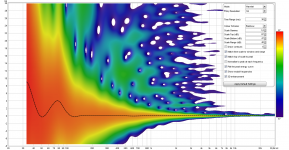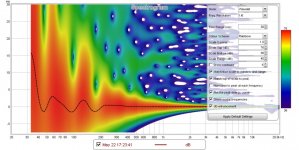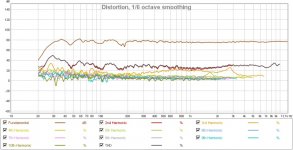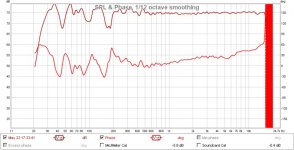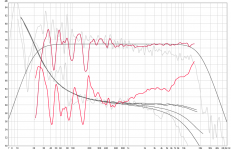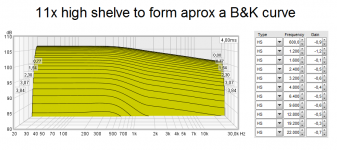As things stand i cant listen to AC/DC, Foo figters etc without turning off the speakers in the first 10 seconds.
The measurements on and off axis look good. Distortions are really low.
So is the speaker just too transparent for these harsh sounding tracks? I am not sure whats going on
The measurements on and off axis look good. Distortions are really low.
So is the speaker just too transparent for these harsh sounding tracks? I am not sure whats going on
any thoughts on if the new SB Satori midranges are worth a try?
I do realize there is a lot of disappointment on the specs that was published, they seem to be pretty much the MW versions with slightly higer sensitivity
I do realize there is a lot of disappointment on the specs that was published, they seem to be pretty much the MW versions with slightly higer sensitivity
SEAS make a range of coaxials but they are expensive compared to the KEF R series and the performance on paper doesn't look as good.As nice as this driver is and as nice as the B&W FST is, i dont think i want to go through the hassle of acquiring them. But would have been nice if an upper midrange+tweeter combo was available as a coax from seas/SS/SB and likes.
As things stand i cant listen to AC/DC, Foo figters etc without turning off the speakers in the first 10 seconds.
The measurements on and off axis look good. Distortions are really low.
So is the speaker just too transparent for these harsh sounding tracks? I am not sure whats going on
If these are compressed and clipped tracks then having difficulty listening to them on a hi-fi is common. Stick them on an MP3 player and listen to them when puffing and panting while exercising via ear buds might be a reasonably constructive solution.
any thoughts on if the new SB Satori midranges are worth a try?
I do realize there is a lot of disappointment on the specs that was published, they seem to be pretty much the MW versions with slightly higer sensitivity
My recommendation as given earlier would be to find out the cause of the problem before trying to fix it. Use your DSP to play around with the crossover to determine if it alters what you don't like. If it doesn't then you will need to look elsewhere to find the source of the problem.
If you want to experiment then a soft rather than hard midrange and a higher crossover is one option. Another might be a tweeter with a waveguide like the SEAS DXT that fits the hole in your baffle.
As things stand i cant listen to AC/DC, Foo figters etc without turning off the speakers in the first 10 seconds.
The measurements on and off axis look good. Distortions are really low.
So is the speaker just too transparent for these harsh sounding tracks? I am not sure whats going on
Can't know just guessing based own findings and reminds me bit when acoustic offset is many cycles off or DSP phase linearization for XO points or system stop bands are exaggerated. Can you share looking into latest saved REW measurement REW plot "Spectrogram" with settings as below and if dashed line that show peak energy curve is too nervous wriggled at frq resolution 1/6 then set it to 1/3. Think for a DSP steered system with phase repair line should be fair strait down to 100-500Hz area depending how much room acoustics is into measurement and then some relative small mS-numbers lag for deep bass, your XO points 60/300/2000Hz will show up if acoustic offset or XO point phase linearization is way off. Not shure understand note about "without turning off speakers in the first 10 seconds" but own findings is if that line isn't fair strait on design axis with smoothing set 1/6 or 1/3 AC/DC will sound awful.
Attachments
Last edited:
As things stand i cant listen to AC/DC, Foo figters etc without turning off the speakers in the first 10 seconds.
The measurements on and off axis look good. Distortions are really low.
So is the speaker just too transparent for these harsh sounding tracks? I am not sure whats going on
Sorry, late-comer here. Where abouts are the measurements? Post #355?
What is it about the music that makes you turn them off?
I have some speakers that measure flat, and really like them playing Foo Fighters, AC/DC, and pretty much anything else, though mine are 2x10"+1.4" PA speakers, so distortion is very low at domestic levels.
Have you measured the distortion on yours? I'm wondering if there's some rise in distortion around the mid-tweeter crossover region, since you mention the XO frequency is a bit on the edge for both of those drivers.
Have you tried the B&K curve? - I find it a subjectively relaxed presentation, but prefer a bit more top end.
Chris
Can't know just guessing based own findings and reminds me bit when acoustic offset is many cycles off or DSP phase linearization for XO points or system stop bands are exaggerated. Can you share looking into latest saved REW measurement REW plot "Spectrogram" with settings as below and if dashed line that show peak energy curve is too nervous wriggled at frq resolution 1/6 then set it to 1/3. Think for a DSP steered system with phase repair line should be fair strait down to 100-500Hz area depending how much room acoustics is into measurement and then some relative small mS-numbers lag for deep bass, your XO points 60/300/2000Hz will show up if acoustic offset or XO point phase linearization is way off. Not shure understand note about "without turning off speakers in the first 10 seconds" but own findings is if that line isn't fair strait on design axis with smoothing set 1/6 or 1/3 AC/DC will sound awful.
BYRTT,
here is the plot.
Attachments
Sorry, late-comer here. Where abouts are the measurements? Post #355?
What is it about the music that makes you turn them off?
I have some speakers that measure flat, and really like them playing Foo Fighters, AC/DC, and pretty much anything else, though mine are 2x10"+1.4" PA speakers, so distortion is very low at domestic levels.
Have you measured the distortion on yours? I'm wondering if there's some rise in distortion around the mid-tweeter crossover region, since you mention the XO frequency is a bit on the edge for both of those drivers.
Have you tried the B&K curve? - I find it a subjectively relaxed presentation, but prefer a bit more top end.
Chris
I think i did try a drooping response, but not sure if specifically B&K.
So its a subjective description, but i will attempt to describe.
Most well recorded, slow, less complex tracks sound wonderful.
Busy tracks with wide spectrum and rapidly changing spectrum, sounds like ehhmm... Crap!
Sound is strained and compressed. Such a song heard recently on Lxmini is smooth and effortless. Some of that i attribute to the comfortable XO point in Lxmini at 700Hz/LR2, rest to a carpeted room with large fabric couch and of course the omni/dipole pattern of lxmini. But with such high grade drivers, amps and (a questionable but unlikely to be the suspect) Motu DAC, i am surprised the DSP RC4 is so far behind.
from the room response, its hard to predict how good the sub, bass XOs are done. But the response is good down to 200Hz in my room and the mid/high regions look flat and smooth.
As i have learnt and understood, the design was compromised at several levels and the DSP option has managed to salvage it to an excellent extent.
But unfortunately my overall assessment is still poor considering the materials used.
I am not sure, but my current thinking is, that the small, low sensitivity mag driver W15CY combined with the T25CF001 tweeter is probably not well suited for that kind of music.
Last edited:
Can you try a distortion sweep at a higher level?
You might want to cover your ears - those kHz tones sound very piercing.
I don't like that 3rd HD peak at 2.7kHz. That's probably related to cone breakup of the mid. Can you put a deep, high-Q notch at 2.7kHz on only the mid driver?
Chris
You might want to cover your ears - those kHz tones sound very piercing.
I don't like that 3rd HD peak at 2.7kHz. That's probably related to cone breakup of the mid. Can you put a deep, high-Q notch at 2.7kHz on only the mid driver?
Chris
If a full orchestra does not sound clearer compared to the semi-omni 2 way then something is likely not right somewhere with the implementation.Busy tracks with wide spectrum and rapidly changing spectrum, sounds like ehhmm... Crap!
The measurements show the midrange resonance has not been nuked. I would suggest adding that to the head of the list of things to try because what you describe would seem to be consistent with a weakly resonating hard midrange.
Your measurements look a bit flat. What do the unsmoothed plots look like? How much processing are you applying? What does the uncompensated microphone response look like? Are you using FIR filters for the midrange/tweeter crossover and if so what does the impulse response look like on-axis and off-axis? There is the potential with symmetric filters to get things looking really nice on-axis but unacceptably horrible elsewhere.
BYRTT,
here is the plot.
Thanks and think it looks good.
Then you shared more plots and stumbled over your upward direction of phase above 600-1200Hz area and have traced your plot to make one overlay that show my own two-way system and how a textbook BW2 20-20000Hz band pass device will approx. behave under 44,1/48/96/192kHz measurement system, will say maybe your trace go a little lower using button "Estimate IR Delay" but pretty shure it will still be upward. So think there it some to look at and mixed with nice help from chris661 and andy19191 looks like its mid and tweeter integration that need a service to get AC/DC going. While we have nice modern power into DSP to correct phase and even at stop bands we can go flat if we want think you should start give your system a phase response that is close to systems real frq response bandwidth, reason for me to say this is because have myself tried over correction or totally flat system and while some tracks then go crazy high in realism other tracks is not good and maybe this is because tracks is mixed/mastered on IRR systems. Tip to make a target curve for your system and use it in a REW overlay is simply start Rephase and on "Minimum-Phase Filters" tab make a pass band that replicate your system and save IRR-wav file in same sample rate as your measurements system is running and import it to REW.
Another thing regarding sound quality is because conversation with wesayso over Rephase thread noticed it looked like your audio device into JRiver is locked at 96kHz and then will say from own experience then don't play tracks from same player other than 96kHz material if DSP chain and DAC's is locked, lower sample rate material for me then sound unnatural probably because of missing related HF low cut filters, and speculate if your AC/DC track was a CD version played under that same JRiver with locked 96kHz DSP chain and DAC's.
Also attach filter data that would be close to B&K curve.
Attachments
Last edited:
Had little AC/DC research with reverse phase filter close to previous plot, while its not same obvious change as when frq curve is changed it was bit harsch and away goes the delicate sound i spent a year on by trail and error with JRiver as DSP steering, gave it a chance also up-sampling therefor the two trees below track list but filter degrade also this scenario.
Attachments
Sorry folks. busy at work.
But did try out the following suggesions made. There is no noticeable difference.
1. Tried 44.1KHz filters and no resampling in Jriver
2. A narrrow notch to remove the distortion peak in W15
The mid/high is not comparable to Lxmini and this subjective conclusion is shared by three people.
will continue investigating when time allows, but other pointers are welcome
thanks
But did try out the following suggesions made. There is no noticeable difference.
1. Tried 44.1KHz filters and no resampling in Jriver
2. A narrrow notch to remove the distortion peak in W15
The mid/high is not comparable to Lxmini and this subjective conclusion is shared by three people.
will continue investigating when time allows, but other pointers are welcome
thanks
Looks like progress.But did try out the following suggesions made. There is no noticeable difference.
1. Tried 44.1KHz filters and no resampling in Jriver
2. A narrrow notch to remove the distortion peak in W15
They should sound different because the directivity is significantly different. It would be more of a problem if they did sound similar. What I picked up on, and I hope I have not misunderstood this, is that you were reporting complex music like large orchestra is less clear and precise on your speakers compared to the semi-omni 2 ways? Not a preference for which sounded better but that your speakers lacked clarity in comparison.The mid/high is not comparable to Lxmini and this subjective conclusion is shared by three people.
Yes actually that is what i meant.
But in what way would they be sounding different due to the different directivity pattern?
My speaker offers less clarity in the mid/tweeter range.
Very hard to describe what i'm hearing. But the lxmini sounds very smooth and effortless, while mine comparatively sounds subdued and less refined.
But in what way would they be sounding different due to the different directivity pattern?
My speaker offers less clarity in the mid/tweeter range.
Very hard to describe what i'm hearing. But the lxmini sounds very smooth and effortless, while mine comparatively sounds subdued and less refined.
and indeed on complex tracks, the loss of control is more noticeable.
Btw, could u point to a example orchestra track which i could try out?
Btw, could u point to a example orchestra track which i could try out?
Again subjective statements but this is the best i have since the on/off axi and distortion measurements dont seem to show anything off
1. I find the tweeter's output to be not smooth and crystal clear at about 75 db listening level, again on complex tracks (could be poor recording but hard to say, because a lot of rock music seems to show this) and i did observe Lxmini handling these much better
2. W15 as clear as it is seems weak or dull. Not the effortless smoothness and dynamic feel when listening to the Lxmini
Is the W15's sensitivity a limiting factor? Is the low 300Hz HP crossover demanding on it? The W15 cone appears to have a mass of about 10g, does that factor in how well a driver sounds in the midrange
the W15 rear opening on the baffle was considerably opened up, but could that still be contributing reflections and back flow restrictions?
1. I find the tweeter's output to be not smooth and crystal clear at about 75 db listening level, again on complex tracks (could be poor recording but hard to say, because a lot of rock music seems to show this) and i did observe Lxmini handling these much better
2. W15 as clear as it is seems weak or dull. Not the effortless smoothness and dynamic feel when listening to the Lxmini
Is the W15's sensitivity a limiting factor? Is the low 300Hz HP crossover demanding on it? The W15 cone appears to have a mass of about 10g, does that factor in how well a driver sounds in the midrange
the W15 rear opening on the baffle was considerably opened up, but could that still be contributing reflections and back flow restrictions?
the rooms itself is definitely playing a role. I am trying to bring that Lxmini setup to my room and do some listening and measurements.
Also need to post the smoothness curves of my speaker from listening position
Also need to post the smoothness curves of my speaker from listening position
What waggles our eardrums in a room is mainly indirect sound not direct sound although the brain tends to pay more attention to the direct sound. The frequency response of that sound follows from the directivity of the speakers. The on and off-axis frequency response dominates how a speaker sounds that is not being overdriven. It is pretty much the only thing that Toole considers in his book on the sound of speakers in rooms. The room of course influences the indirect sound.
Some test tracks here if this is the sort of thing you are after?
Over 75 dB the tweeter is not clear but it is below? Unless you are long way away in a large room that seems to be too low a level for it to be the tweeter running out of displacement and generating high distortion. The 2 kHz crossover frequency with 24 dB/octave slopes is on the low side but doesn't look a problem. Changing with level indicates a non-linear problem and the obvious one there is the midrange resonance which tests show not to be the case. Am I right in saying you are hearing a lack of clarity but not measuring a noticeable rise in measured distortion? If so, we almost certainly need to be looking elsewhere.
The W15 is a woofer/midwoofer rather than a midrange and so the 300 Hz high pass is no problem at all. The sensitivity and the maximum SPL is more of a concern for a large speaker. It will be the driver that starts to distort first and at a significantly lower level than a conventional decent midrange. As a rule of thumb you are looking at a 6 dB drop at 2m, a 12 dB drop at 4m and peaks roughly 20dB above average levels. So if your 75 dB level is an average one at 4m then the peaks at 1m will be 75+12+20 = 107 dB which is starting to reach the limits of your insensitive midrange. If this is to be the cause it must show in relevant distortion measurements.
Restricted space behind the midrange has the potential to cause issues. Here are some measurements suggesting what to look for. I am not sure how you would test if this is the cause. Perhaps by reblocking and if you can hear no change then it is not the problem?
To repeat something I asked earlier that may not have been understood. Are you using symmetric FIR filters with a significant number of coefficients in the crossover? If so, that may be the problem but it is a linear effect and so would be expected to be present at all SPLs.
Some test tracks here if this is the sort of thing you are after?
Over 75 dB the tweeter is not clear but it is below? Unless you are long way away in a large room that seems to be too low a level for it to be the tweeter running out of displacement and generating high distortion. The 2 kHz crossover frequency with 24 dB/octave slopes is on the low side but doesn't look a problem. Changing with level indicates a non-linear problem and the obvious one there is the midrange resonance which tests show not to be the case. Am I right in saying you are hearing a lack of clarity but not measuring a noticeable rise in measured distortion? If so, we almost certainly need to be looking elsewhere.
The W15 is a woofer/midwoofer rather than a midrange and so the 300 Hz high pass is no problem at all. The sensitivity and the maximum SPL is more of a concern for a large speaker. It will be the driver that starts to distort first and at a significantly lower level than a conventional decent midrange. As a rule of thumb you are looking at a 6 dB drop at 2m, a 12 dB drop at 4m and peaks roughly 20dB above average levels. So if your 75 dB level is an average one at 4m then the peaks at 1m will be 75+12+20 = 107 dB which is starting to reach the limits of your insensitive midrange. If this is to be the cause it must show in relevant distortion measurements.
Restricted space behind the midrange has the potential to cause issues. Here are some measurements suggesting what to look for. I am not sure how you would test if this is the cause. Perhaps by reblocking and if you can hear no change then it is not the problem?
To repeat something I asked earlier that may not have been understood. Are you using symmetric FIR filters with a significant number of coefficients in the crossover? If so, that may be the problem but it is a linear effect and so would be expected to be present at all SPLs.
- Status
- Not open for further replies.
- Home
- Loudspeakers
- Multi-Way
- Advice needed on 4 Way loudspeaker
